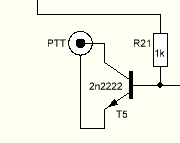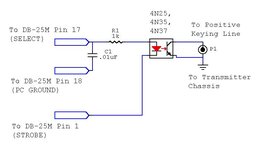neazoi
Advanced Member level 6
Hi,
I want to key a transmitter using an external circuit. Usually the transmitter is keyed by grounding one of it's pins in a socket it has.
I want to avoid ground loops and the classic solution is to key the transmitter using an opto-isolator.
However will this simple circuit shown work?
Notice that the emitter is not connected to the ground of the external keyer circuit, but it is brought to the plug which connects to the transmitter. The outer shell of this plug is connected to the transmitter ground.
Will this circuit work?
I want to key a transmitter using an external circuit. Usually the transmitter is keyed by grounding one of it's pins in a socket it has.
I want to avoid ground loops and the classic solution is to key the transmitter using an opto-isolator.
However will this simple circuit shown work?
Notice that the emitter is not connected to the ground of the external keyer circuit, but it is brought to the plug which connects to the transmitter. The outer shell of this plug is connected to the transmitter ground.
Will this circuit work?

